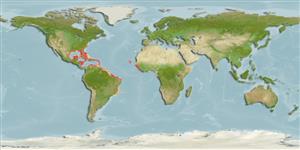Environment: milieu / climate zone / depth range / distribution range
Ecologie
marien demersaal; diepte 1 - 120 m (Ref. 36484), usually ? - 15 m (Ref. 3589). Tropical; 40°N - 24°S, 99°W - 9°E (Ref. 5222)
Western Atlantic: Massachusetts, USA and Bermuda to the Gulf of Mexico, the Caribbean and southern Brazil. Eastern Atlantic: Ascension and St. Helena islands; dubious records from the Canary Islands, Cape Verde and South Africa (Ref. 1496, 1953, 6572) are discussed by Heemstra (Ref. 6512). Also recorded from eastern Atlantic from Sao Tome in the Gulf of Guinea and from the Azores (Portugal) (Ref. 089707).
Lengte bij maturiteit / Grootte / Gewicht / Leeftijd
Maturity: Lm 30.4, range 25 - 36 cm
Max length : 65.0 cm TL mannelijk / geslacht onbekend; (Ref. 118680); common length : 35.0 cm TL mannelijk / geslacht onbekend; (Ref. 5217); max. gepubliceerd gewicht: 4.5 kg (Ref. 118249); max. gerapporteerde leeftijd: 25 Jaren (Ref. 118249)
Dorsale stekels (totaal) : 11; Dorsale zachte stralen (totaal) : 16 - 17; Anale stekels: 3; Anale zachte stralen: 8. Maxilla without scales. Preopercle with rounded, only slightly enlarged, spines at its angle. Opercle with 3 flat spines, middle one the largest. Pelvic fins shorter than pectorals and shorter than longest dorsal spine. Bases of soft dorsal and anal fins covered with scales and thick skin. 2 or 3 dark saddles along base of dorsal fin and another on top of caudal peduncle. Tan with red spots on head, body and fins, spots becoming larger ventrally (Ref. 26938); characterized further by: body depth less than head length, 2.6-3.2 times in SL; head length 2.1-2.5 in SL; interorbital area flat or slightly concave; preopercle evenly serrate; smooth subopercle and interopercle; subequal posterior and anterior nostrils (Ref. 089707).
Inhabits rocky reefs. Usually solitary (Ref. 29). Difficult to approach (Ref. 9710). Juveniles often seen in rockpools (Ref. 86997). Feeds mainly on crabs (67%) and fishes (20%). In the Ascension I., feeds on juvenile Melichthys niger and young sea turtles. Its flesh is of good quality. Marketed fresh. Angling: Like other grouper, rock hind are caught by fishing at the right depth over an irregular bottom (Ref. 84357).
Levenscyclus en paargedrag
Maturiteit | Voortplanting | Paaien | Eieren | Fecunditeit | Larven
Heemstra, P.C. and J.E. Randall, 1993. FAO Species Catalogue. Vol. 16. Groupers of the world (family Serranidae, subfamily Epinephelinae). An annotated and illustrated catalogue of the grouper, rockcod, hind, coral grouper and lyretail species known to date. Rome: FAO. FAO Fish. Synop. 125(16):382 p. (Ref. 5222)
Status op de Rode Lijst van het IUCN (Ref. 130435: Version 2024-2)
Gevaar voor de mens
Reports of ciguatera poisoning (Ref. 31172)
Gebruik door de mens
Visserij: van groot commercieel belang; sportvis: ja
Tools
Speciale rapporten
Download XML
Internetbronnen
Estimates based on models
Preferred temperature (Ref.
123201): 24.2 - 28.1, mean 27.3 °C (based on 1043 cells).
Fylogenetische diversiteitsindex (Ref.
82804): PD
50 = 0.5000 [Uniqueness, from 0.5 = low to 2.0 = high].
Bayesian length-weight: a=0.01202 (0.00755 - 0.01914), b=3.10 (2.97 - 3.23), in cm total length, based on LWR estimates for this species & Genus-body shape (Ref.
93245).
Trofisch niveau (Ref.
69278): 3.5 ±0.4 se; based on diet studies.
Weerstandsvermogen (Ref.
120179): laag, minimale populatieverdubbelingstijd 4,5-14 jaar (K=0.11).
Fishing Vulnerability (Ref.
59153): High vulnerability (63 of 100).
Nutrients (Ref.
124155): Calcium = 86.2 [37.2, 188.8] mg/100g; Iron = 0.991 [0.462, 2.360] mg/100g; Protein = 17.7 [16.1, 19.2] %; Omega3 = 0.203 [0.104, 0.371] g/100g; Selenium = 71.6 [34.9, 165.7] μg/100g; VitaminA = 32.5 [8.0, 126.3] μg/100g; Zinc = 1.24 [0.78, 2.01] mg/100g (wet weight);
